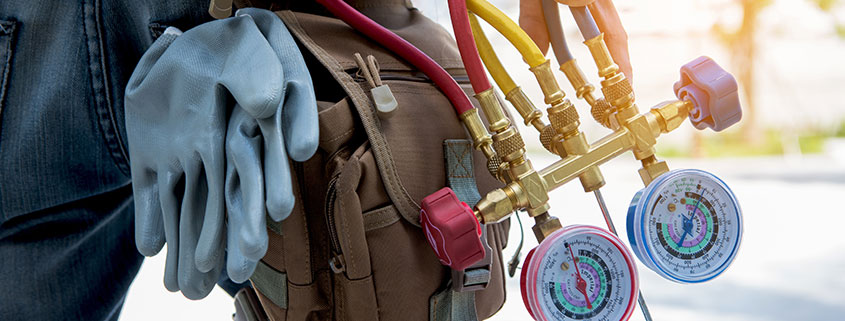Why Property Owners are Switching to ductless mini splits for Modern HVAC Needs
Why Property Owners are Switching to ductless mini splits for Modern HVAC Needs
Blog Article
Just How a Warm Pump and Heater Interact to Enhance Your Home's Home heating Performance
Comprehending just how a heatpump and furnace interact is essential for home owners seeking effective home heating solutions. Each system has its strengths, supplying a well balanced strategy to home comfort. The heatpump masters modest temperatures, while the heater delivers quick heat during severe cold. This harmony not only decreases power costs yet also boosts the life expectancy of both devices. What variables influence this cooperation, and exactly how can homeowners optimize their benefits?
Recognizing Heat Pumps: Exactly How They Function
Although many individuals may be not familiar with their internal workings, heatpump play a vital duty in contemporary home heating systems. These devices run by moving heat from one location to one more, making use of the concepts of thermodynamics. In colder months, a heat pump extracts warm from the outdoors air, ground, or water, and transfers it inside to warm up the home. Conversely, during warmer months, it can turn around the process, functioning as an a/c by expelling heat from inside to the outside.Heat pumps contain an evaporator, condenser, compressor, and development valve. The refrigerant within the system takes in heat as it evaporates at low temperatures and stress. The compressor then increases the pressure and temperature level of the cooling agent, permitting it to launch warm as it condenses. This effective process can significantly minimize energy consumption compared to conventional heating methods, making warmth pumps a sustainable choice for environment control in homes.
The Duty of Heating Systems in Home Home Heating
Heating systems play a crucial duty in home heating by supplying a dependable source of heat throughout the chillier months. They run by creating warmth with combustion or electrical resistance, dispersing it throughout the home by means of ducts or radiant systems. The efficiency of a heating system is typically measured by its Yearly Fuel Usage Efficiency (AFUE) ranking, which suggests how effectively the device converts fuel into heat.Furnaces can utilize numerous energy resources, consisting of gas, oil, lp, or electricity, allowing property owners to select one of the most appropriate alternative for their requirements. Unlike heat pumps, which might have a hard time in severe cold, furnaces keep constant efficiency, making sure that indoor temperature levels continue to be comfy regardless of outside problems. Additionally, modern heaters typically come geared up with advanced innovation, such as variable-speed blowers and clever thermostats, enhancing their performance and responsiveness. This versatility makes heating systems an important element in comprehensive home heating techniques.

Advantages of Using Both Systems With Each Other
Incorporating the strengths of both heating systems and heatpump can result in a more efficient and efficient home heating solution. Using both systems permits property owners to capitalize on the heatpump's energy efficiency during milder temperatures while relying upon the furnace for more severe cold conditions. This double approach can greatly reduce power expenses, as heatpump take in less electricity than typical home heating approaches when temperatures are moderate.Additionally, making use of both systems with each other can enhance comfort degrees in the home. Heatpump can provide consistent, also heating, while furnaces can promptly elevate ambient temperatures when needed. In addition, the combination of both systems can prolong the life-span of equipment by decreasing wear and tear on each unit, as they share the workload. Ultimately, homeowners can enjoy a well balanced, economical heating option that adjusts flawlessly to varying climate condition, ensuring a warm and welcoming home throughout the wintertime months.
How Heat Pumps and Furnaces Enhance Each Various Other
They create a corresponding home heating system that takes full advantage of performance and convenience when home owners integrate warm pumps and heaters. Warmth pumps run by transferring warmth from the outside air or ground, making them highly efficient in moderate climates. They succeed during milder temperature levels, providing cost-effective home heating. On the other hand, furnaces create warmth via combustion or electric resistance, delivering strong, immediate warmth during extreme cold conditions.The combination of these two systems permits dynamic modifications based on temperature fluctuations. Throughout warmer months or milder winter days, the heatpump can take the lead, preserving power and decreasing expenses. As temperatures drop, the heater can perfectly engage, guaranteeing consistent heat throughout the home. This synergy not only maximizes power use however additionally boosts the life expectancy of both systems, as each unit runs within its optimal performance range. With each other, they produce a well balanced atmosphere that adapts to differing climate needs.
Maximizing Effectiveness: Tips for Homeowners
Homeowners can boost their home heating performance via a number of useful techniques. Developing a regular maintenance timetable, incorporating clever thermostat innovation, and applying efficient insulation and sealing services are essential actions. These actions not just boost convenience but also minimize energy costs.
Normal Maintenance Set Up
To assure maximum heating performance, developing a routine upkeep schedule is essential for any type of home. Homeowners ought to prioritize routine examinations of both heat pumps and heaters to establish peak performance. This includes altering air filters each to 3 months, as clogged up filters can greatly minimize performance. Additionally, organizing specialist maintenance at least annually allows technicians to determine and attend to prospective problems before they escalate. Home owners should additionally cleanse the heatpump's exterior system to prevent particles build-up that can impede air flow. By adhering to a regular maintenance routine, homeowners not just boost their furnace' efficiency but likewise prolong their life-span, bring about higher convenience and minimized power costs throughout the cooler months.
Smart Thermostat Combination
Incorporating a wise thermostat right into a home heating unit can substantially improve power performance, particularly as it permits for exact control over temperature setups. These devices can find out the house owner's routine and preferences, immediately adjusting the temperature level to enhance comfort while lessening power usage. They can lower heating during times when the home is empty, lowering special info unneeded consumption. Several smart thermostats also provide real-time energy usage information, allowing homeowners to make informed choices concerning their heating routines. Additionally, remote accessibility using smart device apps enables customers to adjust setups from anywhere, making certain the home is warm upon return. On the whole, smart thermostat combination not only improves comfort however considerably adds to power savings and performance.
Insulation and Sealing Solutions
Smart thermostats play an important duty in energy efficiency, but their effectiveness can be considerably enhanced by appropriate insulation and sealing options. Home owners ought to prioritize insulating wall surfaces, floors, and attics to decrease warm loss. High-quality insulation materials, such as spray foam or fiberglass, can considerably enhance thermal resistance. In addition, securing gaps around windows, air ducts, and doors avoids chilly air seepage and warmth retreat. Weatherstripping and caulking work approaches for resolving these leakages - heat pump installation ooltewah tn. Normal examinations for air leakages, in addition to using blower door examinations, can assist recognize trouble locations. By investing in insulation and sealing, home owners can maximize the performance of their furnace, inevitably bring about lowered power intake and reduced utility bills
Common Myths About Warmth Pumps and Furnaces
What misconceptions border heat pumps and heating systems? Many people wrongly think that heatpump are inadequate in chillier climates. In truth, contemporary heatpump are created to run effectively also in reduced temperature levels, giving trusted home heating throughout winter months. An additional usual myth is that heaters are always a lot more effective than heatpump. This depends on the details energy resources and efficiency rankings of the systems in question. Some may also assume that using both systems at the same time is unnecessary, however actually, this click to find out more combination can enhance heating performance, especially throughout extreme weather. Furthermore, individuals commonly assume that heatpump call for continuous upkeep, when truthfully, they have similar upkeep needs to standard heating systems. By debunking these misconceptions, house owners can make even more informed decisions concerning their heating alternatives, inevitably resulting in boosted comfort and energy effectiveness in their homes.
Upkeep Factors To Consider for Combined Equipments

Frequently Asked Concerns
Can Warmth Pumps Job Successfully in Extremely Cold Climates?
Warm pumps can have a hard time in exceptionally chilly environments as a result of decreased performance and warmth extraction restrictions. Advancements in technology have led to models designed for better efficiency in such conditions, enhancing their practicality in rough settings.
For How Long Do Warmth Pumps and Furnaces Normally Last?
Heat pumps commonly last 15 to twenty years, while heaters have a lifespan of 15 to three decades. Regular maintenance can expand their long life, guaranteeing reliable operation and minimizing the requirement for premature replacements.

What Is the Average Expense of Installing Both Systems?
The average cost of setting up both a warmth pump and a heater typically ranges between $5,000 to $10,000 - ductless mini splits. Factors affecting this cost consist of system dimension, installation complexity, and local labor rates
Are There Tax Rewards for Using Energy-Efficient Heating Solutions?
Many property owners inquire concerning tax obligation incentives for energy-efficient heater. Different government and state programs typically supply refunds or credit ratings, motivating the fostering of lasting innovations to lower power consumption and promote ecological duty.
Exactly how Do I Pick the Right Dimension Warmth Pump and Furnace?
Picking the ideal dimension warm pump and heating system entails computing the home's square video footage, taking into consideration insulation top quality, and reviewing neighborhood environment. Consulting an expert can ensure excellent system efficiency and power performance based on particular needs. heat pump service. Comprehending exactly how a warmth pump and heater job with each other is crucial for home owners seeking effective heating solutions. In colder months, a heat pump removes warm from the outside air, ground, or water, and transfers it inside your home to heat the living space. When house owners incorporate warmth pumps and furnaces, they create a corresponding heating system that makes the most of performance and comfort. Warmth pumps run by transferring heat from the outdoors air or ground, making them extremely reliable in moderate environments. Warmth pumps can have a hard time in incredibly cool climates due to reduced performance and warm extraction constraints
Report this page